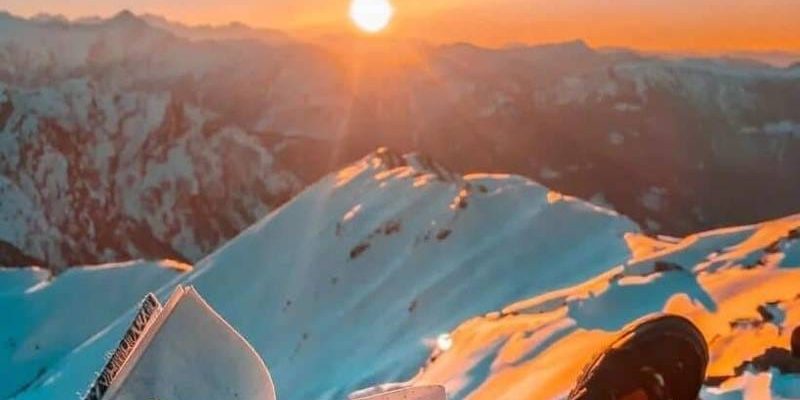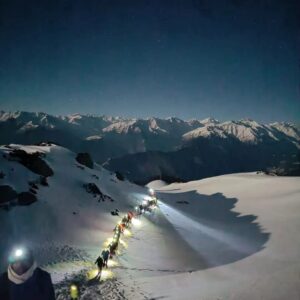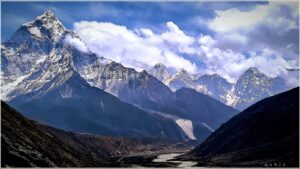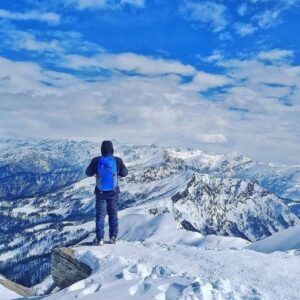When Does Snowfall in Kedarkantha Trek ?
Have you ever wondered when does snowfall in Kedarkantha Trek? What if you could step into a serene winter wonderland where every trail glistens under a thick blanket of snow, and the Himalayan peaks look straight out of a dream? Kedarkantha, one of the most beloved treks in Uttarakhand, transforms completely during snowfall — offering trekkers an unforgettable experience. But the magic depends on timing. So, when exactly is the best time to witness Kedarkantha in its full snowy glory?
The snowfall season in Kedarkantha generally lasts from mid-December to early March, with January and February being the peak months for heavy snow. During this time, Kedarkantha becomes a paradise for snow lovers, offering pristine trails, frost-covered forests, and panoramic views of towering Himalayan peaks like Bandarpoonch, Kalanag, and Swargarohini. But snowfall in Kedarkantha is not just about beauty — it transforms the trek into a magical winter trekking adventure in Uttarakhand that every nature enthusiast dreams of experiencing.
Introduction — The Magic of Snowfall in Kedarkantha
There is something truly enchanting about witnessing fresh snowfall in the Himalayas — a scene where silence speaks louder than words and the world turns into a shimmering white wonderland. The Kedarkantha Trek, often celebrated as one of the best snow treks in India, offers trekkers exactly this magic. Known for its breathtaking winter landscapes, Kedarkantha transforms into a paradise of deep snow, dense pine forests, and panoramic Himalayan vistas, making it a must-do adventure for snow lovers.
Located in Uttarakhand’s Garhwal region, Kedarkantha rises to an altitude of about 12,500 ft, offering one of the most serene and scenic trekking experiences during snowfall. The experience of Kedarkantha snowfall trekking is not just about the physical journey; it is about immersing yourself in nature’s art, where every snowfall reshapes the mountainscape into a pristine masterpiece.
For many, the allure of the Kedarkantha trek lies in its perfect blend of challenge and beauty. Snowfall here creates a magical atmosphere — soft white layers covering the trail, frosted pine trees, and crisp Himalayan air. It is an experience that appeals equally to adventure seekers, nature photographers, and spiritual travelers seeking a moment of peace amidst snow-clad peaks.
Whether it is your first snow trek or a return to the Himalayas, Kedarkantha in winter promises a journey filled with wonder, silence, and a connection with nature that is hard to forget. This introduction marks the beginning of an exploration into the heart of Kedarkantha snowfall trekking, where every step becomes part of a magical Himalayan story.

When Does Snowfall Start in Kedarkantha?
Snowfall in Kedarkantha usually begins in late November, as temperatures drop and the Himalayan ranges start receiving fresh snow. By December, the region is generally covered in a thick white blanket, transforming the Kedarkantha Trek into one of the most beautiful winter treks in India. This period marks the start of consistent snowfall, offering trekkers the perfect blend of adventure and scenic beauty.
The peak snowfall season is between December and February, with January often witnessing the heaviest snowfall. During this time, the entire trail is covered in deep snow, turning the journey into a magical winter wonderland. Frost-covered pine forests, snow-laden meadows, and panoramic Himalayan views make trekking in this season an unforgettable experience.
By March, snowfall decreases, but higher elevations may still retain snow patches. This makes March a transitional month where trekkers can enjoy snow trekking with milder weather. However, for those seeking the true magic of Kedarkantha snowfall, planning the trek in December, January, or February is ideal.
Since snowfall patterns in Kedarkantha can vary each year due to weather changes, early planning and checking weather forecasts are essential. For adventure seekers and snow lovers, knowing when snowfall starts in Kedarkantha is the first step toward experiencing one of the most enchanting snow treks in the Himalayas.
Peak Snowfall Months in Kedarkantha Trek
The true charm of the Kedarkantha Trek is revealed during its peak snowfall months, when the trail and surrounding forests transform into a silent, sparkling world of white. From late December to February, the region experiences its heaviest snowfall, turning every step of the journey into an adventure through knee-deep powder and frosted pine woods.
December offers the first magical blanket of snow, gradually building up into the deep winter of January when Kedarkantha is at its most dramatic. February continues the snowy spell but adds clearer skies and longer days, making it one of the most rewarding times to trek. During this window, nights sparkle with stars above snow-covered camps, mornings open to pink Himalayan sunrises, and the forests remain wrapped in stillness.
These months not only define the best time to experience snowfall in Kedarkantha but also capture the essence of Himalayan winter trekking — untouched beauty, peaceful solitude, and landscapes that seem lifted straight out of a fairy tale.

Monthly Snowfall Trends: December to March
The Kedarkantha Trek is celebrated for its pristine winter landscapes, and the monthly snowfall trends from December to March determine the quality and magic of this trek. Understanding these trends helps trekkers choose the perfect time for their journey and prepare for conditions on the trail.
December — The Start of the Snow Season
December marks the official start of deep snowfall in Kedarkantha. Early December may still have patches of bare ground, but by mid-December, snow covers the entire trail. Snow depth ranges between 6–12 inches, increasing as the month progresses. Temperatures during this month generally vary between -2°C to 8°C during the day and can drop to -8°C to -12°C at night. December treks are perfect for experiencing the gradual transformation of Kedarkantha into a snow-clad wonderland.
January — The Peak Snowfall Month
January is the month when Kedarkantha truly becomes a snow trekker’s paradise. Snowfall is frequent, often heavy, with snow depths ranging from 1–2 feet at lower camps to over 3 feet at higher camps. The trails become completely white, and the surroundings look like untouched alpine meadows. Day temperatures range between -5°C to 5°C, while night temperatures can dip to -12°C or lower. January offers the purest snowfall trekking experience, though it demands proper gear and preparation for extreme cold.
February — Fresh Snow & Ideal Conditions
February continues the heavy snowfall pattern, but with slightly milder weather than January. Snowfall frequency remains high, often producing fresh snow that enhances the trek’s scenic beauty. Snow depths average 1–1.5 feet, and trekkers enjoy clear skies and longer daylight hours, making trekking more comfortable. Day temperatures range between -2°C to 7°C, while nights hover around -8°C to -10°C. February is ideal for trekkers seeking deep snow combined with relatively less extreme cold.
March — Transition to Spring
By March, snowfall decreases, but higher reaches of the Kedarkantha trail retain snow patches, creating a mixed trekking experience. Snow depth ranges between a few inches to about a foot, depending on altitude and weather conditions. March offers the advantage of milder weather, with day temperatures between 3°C to 12°C and night temperatures rarely dropping below -5°C. This month is best suited for trekkers who want to enjoy snowy landscapes without extreme winter conditions.
How Heavy is the Snowfall in Kedarkantha?
The snowfall in Kedarkantha Trek is known to be both consistent and heavy, especially during the peak winter months of December to February. On average, the snow depth ranges from 1 to 2 feet at lower camps like Juda Ka Talab and Kedarkantha Base, while higher altitudes, particularly near the summit, can accumulate 3 feet or more during January — the month of heaviest snowfall.
The intensity of snowfall varies year to year, but trekkers can reliably expect thick snow cover from mid-December until late February. In fact, this is what makes Kedarkantha one of the most popular snow treks in India. The heavy snow transforms dense pine forests into dreamlike settings, covers alpine meadows in white, and creates frozen streams and campsites surrounded by snow walls.
By March, the snowfall starts to thin out, but higher stretches often still retain patches of snow, though not as deep as in mid-winter. For trekkers seeking the most immersive snow trekking experience — with knee-deep trails and breathtaking winter views — January offers the heaviest snowfall in Kedarkantha.
How Long Does the Snow Stay in Kedarkantha?
Snow in Kedarkantha Trek usually begins settling by late November and continues to remain on the trail until March, sometimes even stretching into early April at higher elevations. The duration of snow cover depends on seasonal weather patterns, but trekkers can reliably expect snow-laden trails for nearly four months of the year.
From December to February, the snow is at its deepest and most consistent, often covering the entire trek route from Sankri to the summit. During this period, snow may reach depths of 1–3 feet, making it the ideal time for those seeking a true winter trekking experience.
By March, the snow gradually starts melting at lower campsites, though the upper reaches — especially near Kedarkantha Base and the summit — still retain thick patches. In early April, traces of snow may still be found in shaded areas and higher altitudes, offering a mix of spring landscapes with lingering winter beauty.
In short, the snow in Kedarkantha stays for about four to five months, with the most magical, snow-filled treks taking place between mid-December and late February.
What is Trekking Like During Snowfall in Kedarkantha?
Trekking during snowfall in Kedarkantha is an experience that feels straight out of a Himalayan dream. As snowflakes descend and cover the trail, the forest paths, meadows, and ridges turn silent, broken only by the crunch of fresh snow under your boots. The atmosphere becomes calm and magical — every pine tree looks frosted, every campsite sparkles, and the mountain views appear even more dramatic against the white backdrop.
Walking in snowfall, however, is more than just scenic beauty. The trail gets softer and sometimes slippery, requiring careful footing and the use of trekking poles or microspikes for stability. Campsites like Juda Ka Talab and Kedarkantha Base get blanketed quickly, making the experience of pitching tents and waking up to fresh snow truly unforgettable. The crisp air, the muffled silence of the forest, and the feeling of being surrounded by pure white landscapes make trekking here feel both adventurous and peaceful.
Another unique element is the night sky during snowfall season. With clear skies after fresh snow, trekkers often witness star-studded skies and glowing moonlight reflecting off the snow, creating an otherworldly glow. Add to this the thrill of reaching the summit while flakes drift around you, and Kedarkantha becomes more than a trek — it becomes a once-in-a-lifetime Himalayan snow adventure.
In short, trekking during snowfall in Kedarkantha combines the magic of untouched beauty with the challenge of winter conditions, offering one of the most authentic snow trekking experiences in India.
Snowfall and Safety: What Trekkers Must Know
Trekking in Kedarkantha during snowfall is an unforgettable experience, but it also comes with its own set of challenges. From slippery trails to extreme cold, being prepared is the key to ensuring safety while enjoying the magic of snow.
Trail Conditions Can Be Unpredictable – Fresh snowfall often makes paths slippery and hides uneven terrain. Trekking poles, microspikes, and walking in a line with your group are essential for balance.
Proper Gear is Non-Negotiable – Layered winter clothing, waterproof gloves, insulated boots, and good quality sleeping bags are must-haves to survive sub-zero nights.
Stay Warm and Dry – Snow and moisture increase the risk of hypothermia. Carry extra socks, ponchos, and waterproof jackets to stay protected.
Cold-Related Risks – Frostbite and hypothermia are common dangers in high-altitude snow treks. Numbness in fingers, toes, or uncontrollable shivering are red flags—act immediately to regain warmth.
When snowfall is heavy, visibility can drop, making it difficult to navigate. That’s why staying with your group and following your trek leader’s guidance is crucial. Solo trekking in snowy conditions is highly discouraged.
Emergency Awareness – Always keep a personal medical kit, track weather updates, and allow buffer days in case snowfall delays your itinerary.
Nutrition Matters – Snow trekking requires more energy; keep high-calorie snacks, hydration salts, and warm fluids handy.
Expert Guidance Saves Lives – Trekking with professionals who know Kedarkantha’s winter routes ensures both safety and an enjoyable experience.
Essential Gear for Trekking During Snowfall in Kedarkantha
Clothing Layers – Thermal wear, fleece jacket, down jacket, and waterproof outer shell.
Footwear – Insulated trekking shoes with good grip, gaiters, and extra woolen socks.
Accessories – Woolen cap, muffler/neck warmer, waterproof gloves, sunglasses (for snow glare).
Trekking Essentials – Trekking poles, microspikes/crampons, headlamp, and sturdy backpack with rain cover.
Camping & Sleeping – High-quality sleeping bag (up to -10°C), insulated mat, and tent gear if self-supported.
Other Utilities – Water bottles/thermos, energy snacks, sunscreen, and a personal medical kit.
How to Prepare for Walking in Heavy Snow
Walking in heavy snow during the Kedarkantha Trek requires preparation, the right technique, and proper gear to make the journey safe and enjoyable. Here’s how you can prepare:
Wear Proper Gear – Use waterproof boots with good traction, gaiters, and insulated socks to keep your feet warm and dry. Trekking poles with snow baskets help maintain balance.
Dress in Layers – Wear moisture-wicking base layers, insulating mid-layers, and a waterproof outer layer to stay warm while preventing sweat buildup.
Adjust Your Walking Technique – Take shorter steps, keep your body slightly forward, and place your feet firmly to avoid slipping.
Use Trekking Aids – Microspikes, crampons, or snowshoes (if required) provide extra grip on deep snow and icy patches.
Pace Yourself – Walking in snow uses more energy. Maintain a steady pace, take breaks, and keep hydrated.
Stay Alert to Weather – Snowfall can change trail conditions quickly. Always check weather updates and follow your trek leader’s instructions.
Walking in heavy snow is challenging but rewarding. With the right preparation, it becomes an exciting part of the Kedarkantha snowfall trekking experience.
Tips for First-Time Trekkers Experiencing Snowfall in Kedarkantha
For first-time trekkers experiencing snowfall in Kedarkantha, preparation is the key to making the journey both safe and memorable. Choosing the right season is important — January and February offer the most consistent snowfall and breathtaking winter scenery. Dressing in layers is essential to stay warm and dry, combining moisture-wicking base layers, insulating mid-layers, and a waterproof outer shell. Investing in good gear such as waterproof trekking boots, gaiters, gloves, thermal socks, sunglasses, and trekking poles will make walking in snow easier and more comfortable. Starting early each day is advisable, as trekking in snow can take longer due to deep cover, and daylight hours are shorter in winter. Staying hydrated and carrying high-energy snacks is important, as cold weather can mask dehydration and increase energy consumption. First-time trekkers should stick closely with their group and follow the guidance of the trek leader, since snow conditions can change quickly. Practicing walking in snow-like conditions beforehand can also help improve balance and stamina. Above all, respecting the environment — carrying back all waste, avoiding disturbance to wildlife, and staying on marked trails — ensures that this magical snowfall experience in Kedarkantha remains safe, sustainable, and unforgettable.
Read Our More Blog Posts
Plan Your Kedarkantha Trek with the Locals of Sankri – Authentic, Safe & Affordable Packages”
Kedarkantha Trek with the Locals of Sankri – Authentic, Safe...
Read MoreWinter Sale on Kedarkantha Trek – Best Offers & Deals Upto25% OFF
Winter Sale on Kedarkantha Trek –Get Best Offers, Exclusive Discounts...
Read MoreWhen Does Snowfall in Kedarkantha Trek
When Does Snowfall in Kedarkantha Trek ? Have you ever...
Read More


